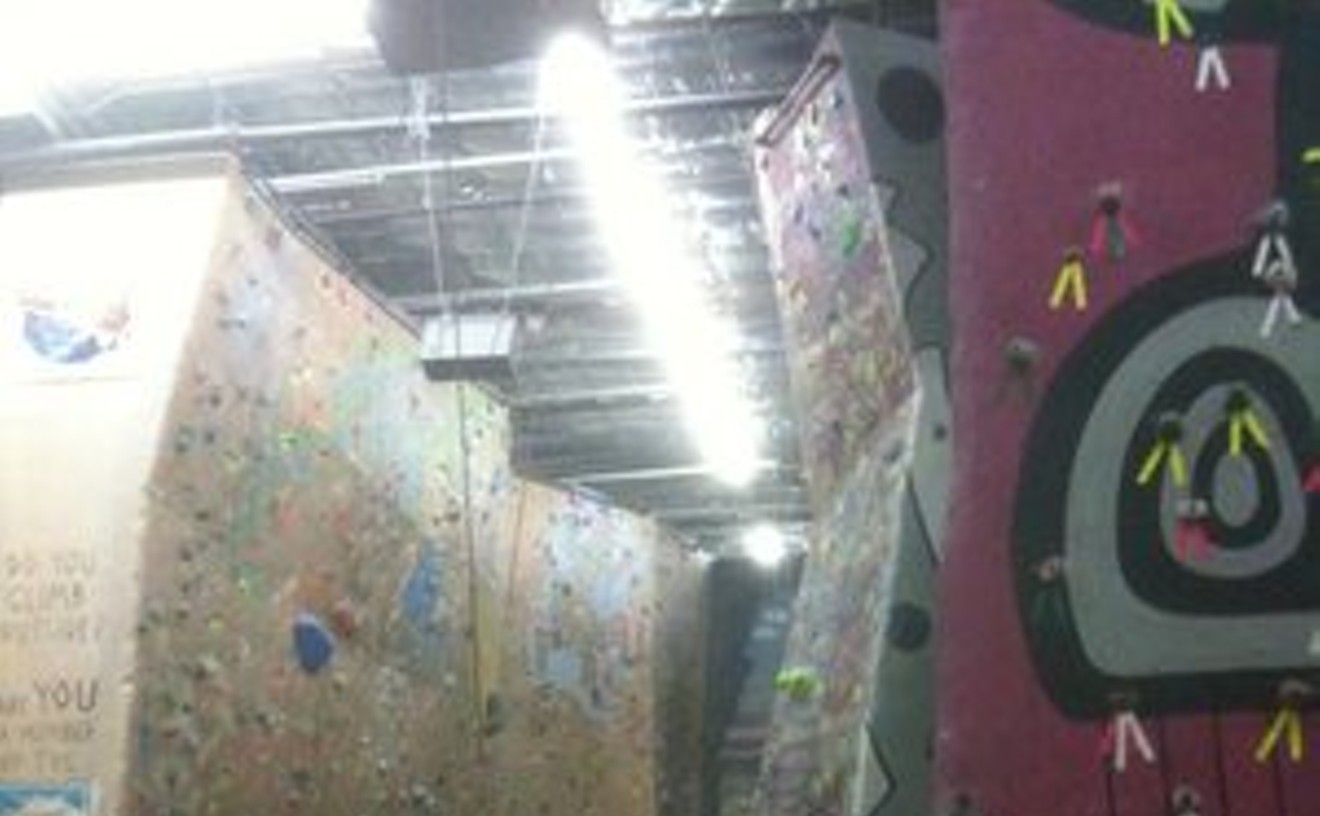BEST PLACE TO SEE A SPRING TRAINING GAME
Hohokam Stadium

Since 1997, the folks running Hohokam Stadium have kept the price of the lawn seats at five bucks. Five bucks to watch the Cubbies, for God's sake! Five bucks to watch the ebullient Cubs fans before the Cubs have been able to begin losing any real games, when Cubs fans are still happy-go-lucky drunks rather than the sour drunks, like Mike Royko back in the 1960s, like Mark Grace back in the '90s, like Cubs fans for the whole glorious 1918 season, which itself was unusually short because of World War I. Simply, Cubs fans are the best. (No, we're not from Chicago; don't even much like the place.) And while cities throughout the Valley scramble to make these spring training fields look like the best of the major league fields, the only thing that matters are the fans. Great fans in a dump beat, say, Diamondbacks fans in Chase Field. Hohokam has Cubs fans in spring. 'Nuff said. The only downside of Hohokam, though, is quite serious. Old Style is served there, but it is served in plastic cups, as though one were at a country music festival outside Cedar Rapids. At Wrigley Field, the Old Style comes in wax cups, something longtime aficionados of "Dog Style," as we called it in college, say makes the beer the best in the world. We always just bought the crap because of the price. But if Cubs fans say so, we say so. Get some wax cups, and Hohokam truly will be Heaven on Earth, a garden of love and hope, before the snake of each doomed season must arrive in Eden.
- 1235 N. Center St., Mesa, 85201 Map
- 480-644-4451
- www.hohokamstadium.com
BEST PLACE TO SPOT SPRING TRAINING PLAYERS OFF THE FIELD
Sluggo's Sports Grill
The Chicago Cubs may be cursed, but that doesn't mean local fans wouldn't want a 'graph from John Mabry or Derrek Lee. Sluggo's is a natural post-practice watering hole for Cactus League players. It's only a mile from the Fitch Park training grounds the Cubs have called their home away from home since 1979. It's also the closest thing to the Wrigley Field clubhouse Phoenix has to offer. Cubs memorabilia hangs on every wall, from jerseys to pennants and team photos. It may be difficult for baseball stars to hide amongst a crowd of devoted sports fans, but regulars at Sluggo's are so used to players popping in for burgers and chili that they don't even bat an eye.
- 161 N. Centennial Way, Mesa, 85201 Map
- 480-844-3888
- www.diamondssportsgrille.com
BEST PLACE TO SEE MERCURY PLAYERS OFF THE COURT
Einstein Bros Bagels
The statuesque ladies of the WNBA are not to be found cruising the nightclubs of Snottsdale en masse. Whether it's because they're clean-living, underpaid, or a little of both, Phoenix Mercury hoopsters tend to fuel up for practices and games at this friendly little cafe in the Safeway shopping center at Seventh Street and McDowell Road. We're not suggesting stalking (it's very wrong, and also these Amazons can kick your ass), but a little broad-daylight appreciation of superior role models goes great with a bagel and schmear, a cheese-steak panini, or a crafted-on-the-premises blackberry lemonade that's just tart enough to build character. The atmosphere is equally wholesome, with smiling staff at the counter and an honest-to-gosh community bulletin board in the back corner. Diana, Cappie and their teammates may be superstars, but they put on their astonishingly long pants one leg at a time, just like the rest of us.
BEST PRO SPORTSWRITER
Joe Reaves
Sorry if this turns out to be the kiss of death for what must be a dream beat for a sports nut like Joe Reaves the national baseball writer for our usually wretched daily rag. We appreciate his knowledge of the game and love of offbeat takes, such as his clever look back at the infamous 1919 Black Sox betting scandal and how it parallels today's steroid crisis. Speaking of drugs, Reaves' piece about the love that pro ballplayers have for greenies (known to the uninitiated as amphetamines) provided quite the jolt for readers. Before he fled the Republic newsroom a few years ago, Reaves was The Man there, writing prolifically and well on sex scandals in the local Catholic diocese and such. That's not surprising, coming from a onetime foreign correspondent (Chicago Tribune) who has two published nonfiction baseball-related books on his rsum. Let's hope that this small tribute doesn't land old Joe back on night cops, where the closest thing to a bat is a billy club.
BEST SUPER FAN
Mike "Tee Guy" Crowley
When we think "super fan," embarrassing images of shirtless drunk dudes painted team colors come to mind. Gross. That's why we were so delighted to discover Mike "Tee Guy" Crowley an ASU football fan so devoted, he has a cult following of his own. And he keeps his shirt on. For the past 12 seasons, Crowley has served as the "tee guy" for the Sun Devils football team, meaning he's the one who runs onto the field after the ball is kicked to retrieve the tiny orange stand (tee) used to hold up the ball. It doesn't sound glamorous, but it's important the stand can't be on the field during the next play and he's got to be quick about it. Crowley's devotion to Devils football has been strong since day one, but his own odd celebrity status was only born a few years ago during the Rose Bowl. Two fans made signs reading "We Love Tee Guy," and a football cult hero was born. We admit it's a little odd that a grown man is timing himself to see how quickly he can retrieve a piece of plastic from the football field, but this guy's too funny and too nice to dislike. Even though it's weird, we can't help but chant along with the crowd: "Tee Guy! Tee Guy!"
BEST PRO WRESTLING SHRINE
Eddie Guerrero's grave at Green Acres Mortuary & Cemetery
As caustic comedian George Carlin once opined, "Death makes you popular." Nowhere in town is this truer than with the gravesite of popular pro wrestler Eddie Guerrero. Ever since the World Wrestling Entertainment superstar known as "Latino Heat" was body-slammed into the ground last November at the Scottsdale cemetery, hundreds of wrestlemaniacs from around the Valley and across the country have peeped his final resting place. Not content with simply paying their respects, these ghoulish grappling groupies have taken pics to post on the Internet and left myriad mementos of the former world champion. Green Acres staffers often have to clean up plenty of pairs of fuzzy dice and keyless car remotes (Guerrero was a lowrider aficionado), copies of wrestling magazines, handmade posters, and even an imitation title belt. Although Eddie loved his fans, as The Undertaker might say, let him rest in peace.
BEST CHEAP THRILL
Arizona Falls
Ask Phoenix newbies what they miss most after moving to the desert, and, whether they say Seattle's rain, Michigan's lakes, or California's beaches, the common denominator is usually water. Which is why this way-cool waterfall, a collaboration by Salt River Project, the Phoenix Art Commission, and the Arcadia neighborhood, is just the place to take 'em. Stand here on a summer night with the spray of the falls hitting your face, and you'd swear you were at a mini-Niagara. Only a little warmer. The site housed the first hydroelectric plant in the city, and now you can see the antique gears through walls of water part of a public art project created by Boston artists Lajos Heder and Mags Harries (they did those Squaw Peak pots that made such a stir, years ago). Today, the falls generate enough hydraulic electricity to power 150 homes. Now that's a cheap thrill!
BEST NOT-SO-CHEAP THRILL
Skydive Arizona
Most everyone has dreamed of skydiving. But the gap between dream and actually jumping out of some plane at 13,000 feet above Arizona can be, um analogy, please? Yes, of course, as big as the gap between you and the ground you're terrified of being pancaked on. This first jump, seemingly a jump to oblivion, must be handled by gentle, competent, cool people to make it the pleasure you imagine beyond the terror you imagine. This is why Skydive Arizona is the place to go if you want to feel safe (or as safe as one can feel) about death-defiance. The staff here seems hand-picked for vibe: very cool, very smart. The equipment used, from aircraft to parachutes, is topnotch and clearly well-maintained. Here you feel the love for the sport, the love for the spiritual renewal and brainpan-frying buzz of free fall. Now, remember, that's just our opinion. We haven't performed any inspections or anything. But we're not alone in our adulation. Skydivers writing into dropzone.com, the leading Web site for skydiving reviews, chose Skydive Arizona hands-down over other skydiving companies in the state. Of 24 reviewers, from novices to experts, Skydive Arizona had an average of five stars per rating. Yes, everyone who went there (at least, everyone who went there and reviewed it on dropzone.com) loved the experience. Other Arizona companies seemed pressed to get one five-star rating. It will cost you $189 on weekdays or $199 on weekends for a first-time tandem training jump. For this jump, your instructor will be with you through the entire experience. For the more advanced skydiver, solo jumps cost only $79. And beyond the jump itself, the Skydive Arizona campus is a joy somewhat austere, but clean and functional. Hanging out here for coffee or drinks afterward can be as much fun as the drop. Well, okay, no, not quite as fun.
BEST PLACE TO CLIMB THE WALLS
Phoenix Rock Gym

We're all for physical fitness (uh . . . in theory, at least), but the treadmill is so damn boring, and lifting weights is for meatheads. So we're stoked on the workout we can get dangling 30 feet in the air at Phoenix Rock Gym. The first trip to the top of the wall is a little scary, but it feels pretty sweet to look down and realize you actually climbed a wall. The best part about this gym which offers 15,000 square feet of climbing surface is the fact that no experience is necessary to climb. And once you get over the awkward feeling of strapping into the harness, you'll realize even a baby can do it. We mean that: Children as young as 2 years old are welcome to climb. For experienced climbers looking for a challenge, the gym offers walls up to 5.13 skill level (for all you non-climbers out there, that translates to "really hard"). That's neat and all, but we'll stick to the beginners' wall for now until we can develop that elusive thing called upper-body strength.
- 1353 E. University Dr., Tempe, 85281 Map
- 480-921-8322
- www.phoenixrockgym.com
BEST BEGINNER'S CLIMB
Praying Monk, Camelback Mountain
Enough, already it's time to get out of the rock gym and climb outdoors. We know indoor climbing walls are fun, but they are to climbing what stationary bikes are to cycling. And there's no better first climb to conquer than Praying Monk. Camelback Mountain is right in the middle of the Valley, meaning that if you really screw up, there are plenty of hospitals and a nearby fire station filled with friendly, trained mountain rescue professionals. But don't worry, the toughest part of your day will probably be finding a parking spot in the tiny lot at Echo Canyon, off McDonald Drive. The Monk is a freestanding, leaning tower of ancient congealed mud, tinted red like the rest of Camelback. A short scramble gets you to the Monk's plateau; the often-shaded, boulder-strewn cubby at the base is a good place to don your climbing shoes. The east face route is bolted so you don't need much gear, just one rope and some quick-draws, which are two carabiners connected to a bit of sewn webbing. Life on the "sharp end" of the rope, as leading is sometimes called, can be a bit unnerving because there's no rope already fixed at the top to catch you when you come off the rock. But the bolts are close together, and you won't run into any life-or-death decisions. A lead fall here, unlikely as that is for a competent climber, would be perfect practice for a more serious climb. You will, however, be mesmerized by the exposure. Your heels will stick out over a hundred feet of air as you look for embedded pebbles to grasp for finger-holds on the orange-pink, not-quite-vertical face. Gym rats should take a good look around as they go up this is real climbing. A pleasurable, free-hanging rappel brings the climbing party back down to earth. You've now graduated from lead school. Next stop: K2.





